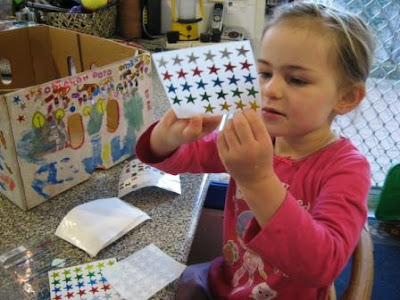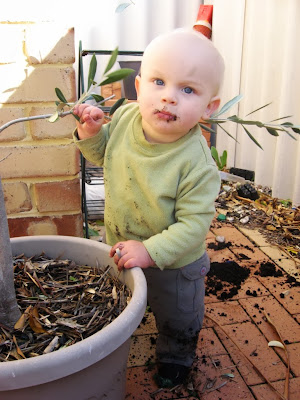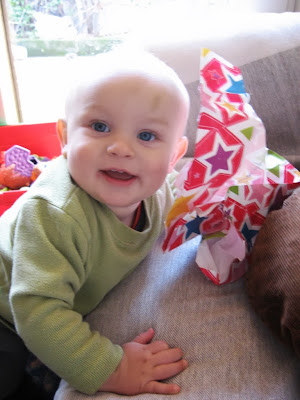Last week our 'baby' turned one!
This post is only very loosely in keeping with the theme of the blog, and largely a gratuitous display of photos of my lovely children, especially our delightful one-year-old.
The loose link is: how to celebrate a one-year-old's birthday without stomping great planetary footprints...
A quick scan of the internet suggests 'celebrate' equals 'party' for most people. I only looked at one or two websites guiding the planning of first birthdays to realise we are way out of touch with mainstream culture here. The average task-list to prepare for a first birthday includes: choosing a theme and colour scheme (that would be what the site selling special-print napkins, paper plates and disposable cups is aiming at, I guess); choosing a guest list; picking a venue; planning a menu; deciding on decorations; preparing games for the bigger kids; Birthday Cake (capital letters please); invitations; scheduling activities; selecting gifts; putting together party bags.
My task-list went something like: What does our boy enjoy? Who will want to celebrate him? How do they enjoy showing that they love him? What does he need (nothing!)? What would be a useful, playful, creative, open-ended addition to our toy collection that he might play with many times in many ways?
It seemed most important to ensure Eva was able to feel his birthday was appropriately marked, and for her to see in how we celebrated him the way we value each member of our family. It was also important to let her give him something that she was involved in choosing.
She chose him a bath duck.
She also decorated him a cardboard box.
She made him at least three birthday cards... there could be more yet - just because his birthday is over is no reason to stop making him cards...
And she helped me make and decorate two birthday cakes.
I think they were perfect. I know full well they would win no prizes in the highly competitive game of children's birthday cake one-up[wo]manship that is rife amongst families of small children and across the internet, but they perfectly express Eva's careful attention to making something wonderful for her brother.
We had cake at home, cake with friends who regularly come to dinner, cake at church, and cake with Tyson's family (that one made by Grandma, demonstrating both loving careful attention AND some cake-decorating prowess).
We had play-dates with his my-side aunties. We had afternoon tea with Tyson's family. A lovely collection of modest, thoughtfully chosen, minimally packaged gifts made their way home with us.
And we spent our son's birthday doing things he enjoys:
Eating letter-pancakes made by his dad;
Mouse-rides with Eva (zoooooom!);
Playing with his sister;
Digging in the potplants and eating dirt;
Showering with mum without watching the clock;
Climbing up things...
...like the shelves under the kitchen bench...
to swipe a cherry off the birthday cake;
Swinging at the playground
And of course, his favourite gift of all, which he has carted around the house until it is in shreds, was the piece of wrapping paper sent across the country by my parents. Gran had to pad it out with a book inside so it didn't get ruined in the mail, but he saw through that immediately and knew the paper was the main event.
Initial Time: Decorating cardboard box: three half-hour(ish) sessions, one for white undercoat, one for colour, one for stickers; an hour making and decorating cakes; half-hour making a batch of afternoon tea muffins
Initial Cost: About $20 - two cakes, one basket of home-made muffins, a rubber duck
Just to be clear, I am not opposed to spending money to celebrate. But I am trying not to spend money just to 'do it right'. If I had found something expensive that would have been a great addition to our household (useful, playful, creative, open-ended, multi-use) I would have quite possibly bought it. The cardboard box was not being cheap-skate - I genuinely think our one-year-old will get more playful, creative use out of that box than any shop-bought item I considered. And it was a craft-activity for his sister, and allowed her to be really engaged with giving something special to her brother.
Ongoing time or cost commitment: Same again come September... how to celebrate a four-year-old's birthday...
Impact: I said it better at Christmas (two posts) but its about shaping the way we and our children view celebration. How do we love each other well? Does it need stuff?
Hopefully our choices also put a few less disposable napkins/ plates/ cups/ cutlery into landfill, along with less plastic packaging and fewer broken plastic toys. Here's an old but good post from Little Eco Footprints on where our plastic toys end up.
Oh, and that bruise in all the photos? That's because he learnt to walk the week before his birthday and walking is a hazardous game...






























